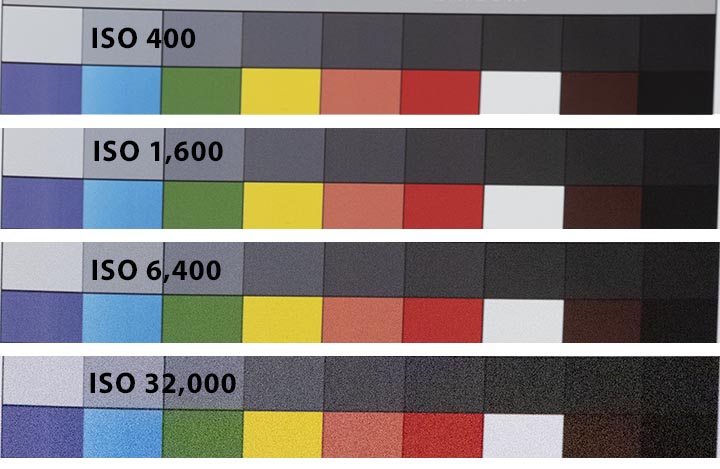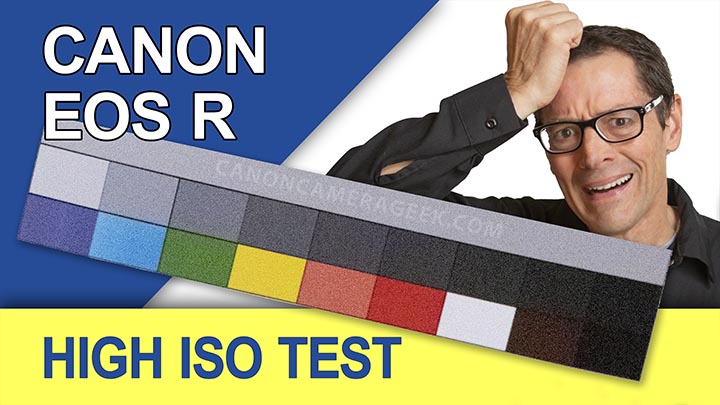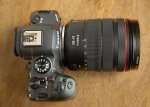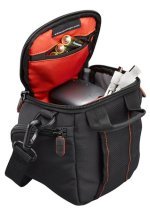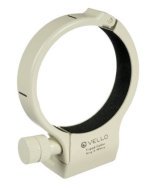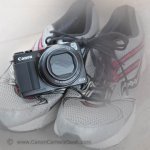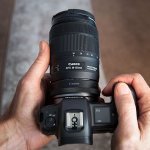Canon EOS R High ISO Test
In terms of image quality (known as IQ), the Canon EOS R has two advantages when it come to doing a high ISO test. I get it. You're interested in knowing how much noise shows up and how sharp the photos are from a Canon EOS R when higher ISO settings are used. So was I.
Realize that there are two initial factors that are in our favor: First, the EOS R has a full frame sensor and secondly, that sensor is not overloaded with too many pixels. Larger full frame cameras have a big advantage over crop-sized and smaller sensor cameras. Size matters. The larger surface of the sensor means you have more area for the camera makers to fit larger pixels on the sensor.
Small sensor camera makers have to reduce the size of the individual pixels to fit enough of them on the sensor for a quality photo. Normally, those smaller pixels aren't as efficient at collecting light and high ISO settings often result in noisy photos. Surprisingly, I tested the 32 MB crop sensor on the Canon R7 for high ISO performance and got these unpredicted results.
The larger pixels of the EOS R are better at collecting light and therefore the EOS R is good in low light situations where you need to use a higher ISO settings to get a good exposure. See the test results below.
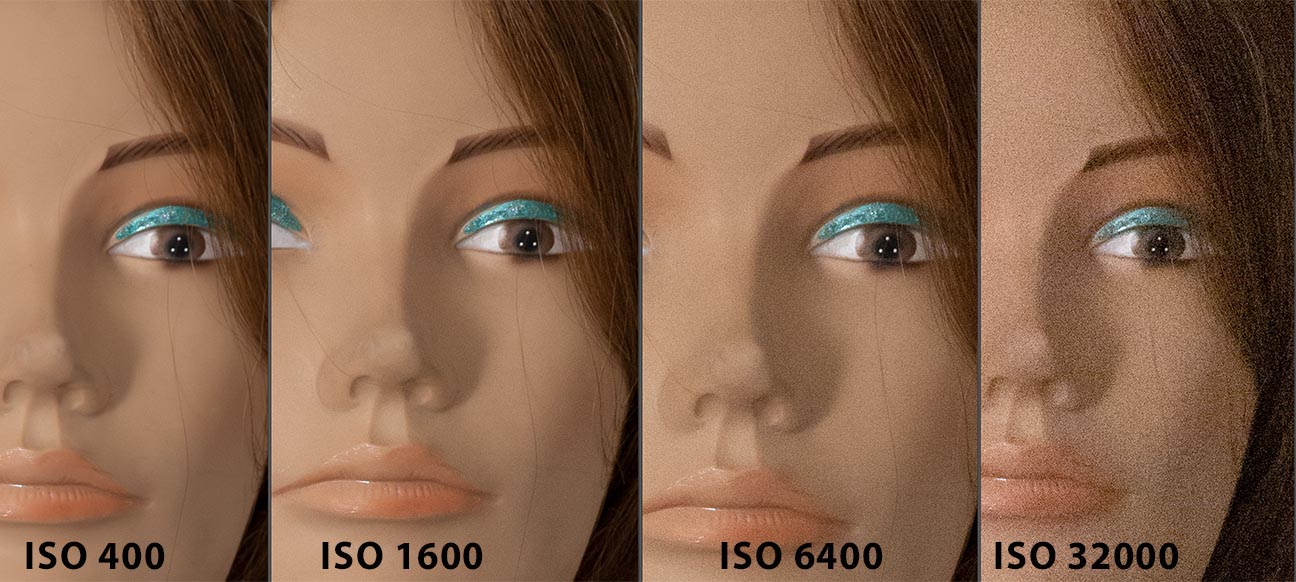 (Cropped to 100% magnification and combined in Photoshop)
(Cropped to 100% magnification and combined in Photoshop)High ISO noise test comparison for the Canon EOS R at different ISO settings
I did the initial high ISO test test with the EOS R mounted to a tripod with an LED panel light illuminating one of the typical subjects that I photograph, in this case a mannequin who would not move at all during the different ISO setting test shots. I shot all the test photos at a constant aperture to maintain the same lens sharpness.
The 4 images above were all cropped at a pixel-peeping 100% to make the comparison valid. Even as high as ISO 6400, the EOS R produced excellent sharpness with minimal noise.
How did the EOS R perform at high ISO
The EOS R showed virtually no noise at ISO 400. At ISO 1600 the camera still gives a very clean image. At ISO 6400 noise is more noticeable, but the image still has solid quality and excellent sharpness. I maxed out the high test at ISO 32,000, and not surprisingly, noise was significant but the image was still quite useable.
High ISO Color Chart Test
Generally, I prefer to test cameras and lenses in situations that are similar to those that I normally shoot rather than static test targets. With the EOS R, I decided to give it the geeky color chart test where there are solid color-filled areas that tend to reveal noise to a much higher extent than the average scenes you photograph.
As you can see from the test result photos below, sharpness declines and noise increases to somewhat unacceptable levels at ISO 32,000.
PART II - Q and A on The Canon EOS R and ISO
Along with the simple high ISO test we did with the EOS R, there are related several inquires that come to mind. Here are the most common questions and answers with respect to ISO settings on the Canon EOS R mirrorless camera.
What is the best ISO for Canon EOS R
You're also likely curious as to what's the best ISO to set your Canon EOS R to. All other factors being equal. the highest image quality for Canon cameras is ISO 160, but that won't work in all situations. The best ISO in terms of convenience and high quality combined is ISO 1600. You'll maintain excellent image quality and have the big advantage of being able to handle less than ideal lighting conditions.
What is the native ISO for Canon EOS R
"NATIVE ISO" refers to the normal range of potential ISO settings that are available to you on your EOS R. EXPANDED ISO refers to an expanded range of ISO settings (at both ends) where the sensitivity range is boosted and it's diminished with software that's in your camera. The EOS R has a native ISO range of 100 to 40,000. The BASE ISO of this camera is ISO 100, the lowest setting you can use without setting your R to an expanded ISO. The expanded ISO range is 50 to 102,400.
Interestingly enough, my first Canon DSLR, the Canon 10D had a native ISO range of only 100-1600. At an ISO setting of 1600 the image noise and loss of detail was quite noticeable and objectionable. The EOS R is significantly ahead of that in terms of high ISO performance, thanks to the remarkable technological advances in digital photography, specifically the design of the sensor and the software that processes the raw data into an image.
How do I expand ISO on Canon EOS R?
The ISO settings on the Canon EOS R can be found under the red camera icon, the third option, in the main menu. Watch this short video to see how easy it is to change to expanded ISO or any of the other ISO settings.
Once you activate the menu screen, you click on the first option to the left, the camera icon. Then select the 3rd column, followed by touching the "ISO Speed Settings" bar.
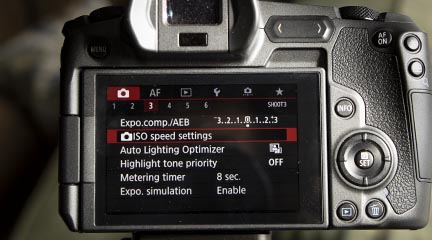 3rd column in the first menu
3rd column in the first menu1
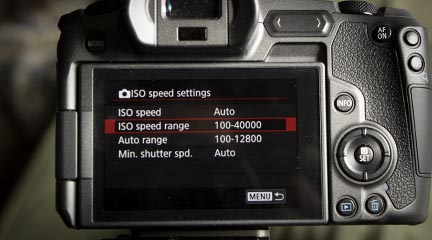 3 ISO options
3 ISO options2
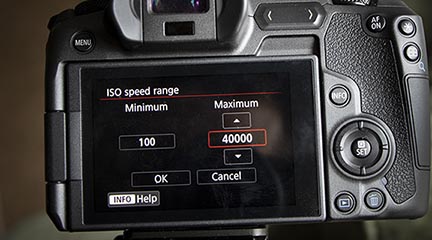 How to expand ISO range
How to expand ISO range3
Once you select "ISO speed settings" you have the options (photo 2) of setting the ISO, setting the ISO range (expand it), and the range of Auto ISO settings you want as options.
When To Use High ISO On The EOS R
Raise your ISO setting when you're in dimly lit situations and you're getting blurry photos due to unusually slow shutter speeds. As you gain experience you'll get to know just how high of an ISO you have to use before you get the results you want.
- Your kids soccer game on a dreary day or late in season when the days are short and it's getting dark
- Birthday cake candles when the lights are off.
- Moonlit, astrophotography, and nighttime photography.
- Indoor photos when you can't/don't want to use flash.
- Handheld macro photos when you need both a fast shutter speed and a small lens opening for good depth of field.
EOS R High ISO Test Summary
Generally, you want to keep your ISO settings as low as possible to get the sharpest photos with the least amount of digital noise. With a good camera that has a large sensor like the Canon EOS R-and it's so affordable for a full frame-you can get get great photos at high ISO settings up to ISO 6400.
You can also shoot in some really dark situations at super ISO settings and still get useable photographs, admittedly with some compromise in image quality.
As an Amazon affiliate Canon Camera Geek receives a small commission from qualifying purchases, at NO added cost to you.


Bruce Lovelace is the publisher of Canon Camera Geek. Read more about him on the About Page. He also publishes how to articles and camera gear reviews at the Photography Tips website.
View some of Bruce's photos on Instagram and Flickr. Join the tribe of followers on YouTube. Bruce also runs photo workshops and provides 1 on 1 digital photography coaching.
Recent Articles
-
My Review of The 10 Best Canon R6 Mark II Features That Impressed Me
Apr 12, 25 08:51 AM
Beyond the Pixel: Discover the Game-Changing Features That Make the Canon R6 Mark II a Must Have Camera -
Canon RF 24-105 Lens Comparison. Guide To Which One Is Right For You
Apr 07, 25 12:47 PM
Which is the best of the 3 versions of the Canon RF 24-105mm Lens for Canon mirrorless cameras? What's The 24-105 Lens Good For -
3 Better Alternatives to Camera Bags From Canon. Helpful Guide To Bags
Apr 03, 25 11:51 AM
After searching for the top best selling Canon bags, I found 3 better alternatives to camera bags from Canon -
Canon 70-200 2.8 Tripod Collar. Article and Video of The Advantages
Apr 03, 25 11:02 AM
Some call it an optional accessory. I say a canon 70-200 2.8 tripod collar is a necessity when using this lens on a tripod or monopod. -
Running With The G1X Mark II, Acting Like a Kid, You Should Try This
Apr 03, 25 10:31 AM
Ever get a new "toy" and want to just play? I did.Got my new Canon compact camera. Went running with the G1x Mark II -
5 Best Canon Camera Types And Which One To Buy. Canon Camera Reviews
Mar 24, 25 01:21 PM
How do you know which is the best canon camera to buy? Don't get fooled.Read this first.
This page may contain affiliate links that pay me a small commission. There is no cost to you. Review the affiliate statement at the very bottom of this page if you want more information.
